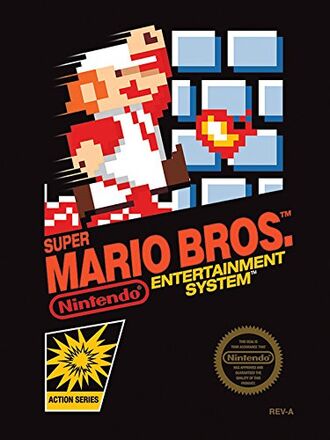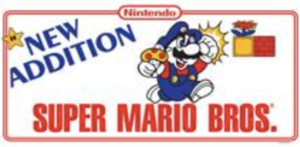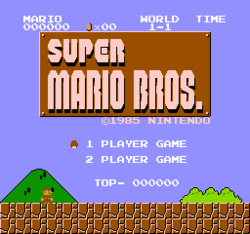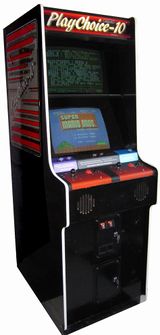Super Mario Bros.
This article is about the 1985 video game. For the film, see Super Mario Bros. (film). For the series, see Super Mario.

| |
| Super Mario Bros. | |
| Developer | Nintendo R&D4 Nintendo R&D2 (Deluxe) |
|---|---|
| Publisher | Nintendo |
| Platforms | NES, Arcade, FDS, SNES, GBC, N64, GCN, GBA, Wii, 3DS, Wii U, NES Classic Edition, Nintendo Entertainment System – Nintendo Switch Online |
| Released | NES: September 13, 1985 Arcade: 1985 FDS: February 21, 1986 SNES: July 14, 1993 GBC: May 10, 1999 GameCube Animal Crossing: September 15, 2002 GBA: February 14, 2004 Wii Virtual Console: December 2, 2006 3DS Virtual Console: January 5, 2012 Wii U Virtual Console: June 5, 2013 NES CE: November 10, 2016 Switch Online: September 18, 2018 Game & Watch: November 13, 2020 |
| Added to Museum |
GC (Animal Crossing): January 20, 2003 Wii All-Stars: January 20, 2012 NES CE: June 22, 2017 Famicom Mini: August 10, 2017 SNES All-Stars+World: December 19, 2018 Unofficial C64: April 26, 2019 Game & Watch (FDS): March 12, 2021 |

|
Super Mario Bros. was first released for the Nintendo Entertainment System by Nintendo in 1985. It was the follow-up to the Mario Bros. series, and started Nintendo's flagship series, the Super Mario series. As such, it was brought to most of Nintendo's subsequent systems, either as ports or through emulation.
Story
An Italian plumber named Mario and his brother Luigi travel from Brooklyn to the Mushroom Kingdom. There, they travel across eight different worlds within the kingdom and collect power-ups to defeat enemies standing in their way, on their quest to rescue Princess Toadstool from Bowser, King of the Koopa.
The first seven worlds have a castle where one of Bowser's minions is disguised as their king and beating these foes will reveal their true nature. Then, upon reaching the dungeon, Mario discovers one of the many Mushroom Retainers that inhabit the Mushroom Kingdom, each of whom lets Mario know that the princess is in another castle.
Finally, upon defeating Bowser at the castle in the eighth world, Mario finally rescues Princess Toadstool. She then gives Mario the option to try a new quest, wherein she is kidnapped again, but Mario must defeat tougher enemies to rescue her.
Development
When it was decided to bring Super Mario to arcades on the VS. System hardware, Shigeru Miyamoto and his team changed and re-arranged levels from Super Mario Bros., and added six new levels to increase the difficulty of the game. The result was VS. Super Mario Bros., a game that, due to the changes in the level structure, the addition of new levels, and the addition of a new ending, was a different experience than the original Super Mario Bros. The enjoyment the development team had in creating harder levels for arcades led to the development of Super Mario Bros.: The Lost Levels, the game originally known as Super Mario Bros. 2 in Japan.
Versions of the game
As Nintendo's flagship title, Super Mario Bros. has been released on many different systems, both through traditional game ports and through emulation. It was released to arcades on the PlayChoice-10 system in 1985. This system allowed playing of up to ten NES-based games before the system's timer ran out.
For home use, it was released for the Family Computer Disk System in 1986. It was re-released on a multi-cart and packaged with the Nintendo Entertainment System twice. It was bundled with Super Mario Bros. on a Super Mario Bros./Duck Hunt multicart in 1988. It was then bundled with Super Mario Bros. and World Class Track Meet on a Super Mario Bros./Duck Hunt/World Class Track Meet multicart in 1990.
It then received an enhanced port for the Super Nintendo Entertainment System as part of Super Mario All-Stars in 1993. In 1997, five worlds from the Super Mario All-Stars version, with exclusive overworld maps, were included in BS Super Mario Collection for the Satellaview broadcast satellite add-on for the Super Famicom.
Next, it received a faithful port to the Game Boy Color in 1999, adapted for the smaller screen resolution, titled Super Mario Deluxe. The game also included Super Mario Bros.: The Lost Levels, which was referred to as Super Mario Bros. For Super Players.
Super Mario Bros. was included as an unlockable item in the 2001 GameCube game Animal Crossing|Animal Forest+, and its 2002 English localization, Animal Crossing. Game codes to unlock the game were given away in Japan as part of a giveaway in Famitsu magazine. It also can be unlocked in all regions with a code entered using an Action Replay device.
The game was then ported to the Game Boy Advance, and released as part of the Classic NES Series in 2004. An emulated version of the NES version was released for the Virtual Console on Wii in 2006. An emulated version of the SNES version of Super Mario All-Stars was released as Super Mario All-Stars Limited Edition on Wii for the 25th anniversary of Super Mario Bros. in 2010. It was released on the Nintendo 3DS Virtual Console in 2012 and on the Wii U Virtual Console in 2013.
Super Mario Bros. was also included as one of the 30 games in the NES Classic Edition miniature video game console, that emulated NES games and resembled a miniature NES, in 2016. It was then released as one of the launch titles of the Nintendo Entertainment System – Nintendo Switch Online service for Nintendo Switch in 2018.
It was also included, along with Super Mario Bros.: The Lost Levels, and Ball, in a Game & Watch handheld video game console in 2020.
Unofficial Commodore 64 port
On April 19, 2019, a port was unofficially released for Commodore 64 by a programmer named ZeroPaige after seven years of work. However, on April 24, 2019, Nintendo issued a cease and desist order and contacted sites hosting it to remove the game from their servers.

